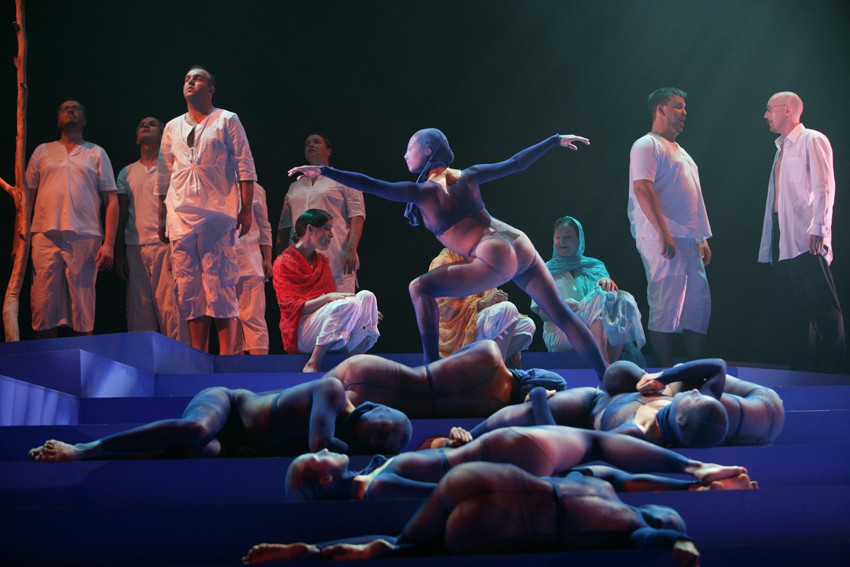State Opera’s Philip Glass Trilogy

Something halfway between Moby-Dick and The Ring might describe the scale and significance of August’s Philip Glass Trilogy as a locally produced operatic event.
Something halfway between Moby-Dick and The Ring might describe the scale and significance of August’s Philip Glass Trilogy as a locally produced operatic event. Minimalist music will always have its share of detractors, but there can be no denying how Philip Glass has changed the course of opera in the present era. He brought opera back into the popular mind, communicating stories of our own time with a musical language that straddles the popular and classical divide. Yes, he did it almost completely by accident when, together with Robert Wilson, he created a giant, experimental, plot-less ‘dream play’ about Albert Einstein with powerfully hypnotic music that exploded all existing categories. On the back of Einstein on the Beach’s unexpected success at the 1976 Avignon Festival, Glass was famously asked to write a ‘real opera’. That request, coming from Hans de Roo of the Netherlands Opera, gave rise three years later to Satyagraha, a shorter, three-hour opera based on Ghandi’s philosophy of passive resistance. Then in 1984 came the third of Glass’s operas on visionary historical individuals; this was Akhnaten, which relates how the ‘heretic’ pharaoh Akhenaten bequeathed to Ancient Egypt a revolutionary new monotheist religion. Extraordinarily, it has taken until now for someone to mount all three ‘portrait’ operas in a single production. Where other opera companies have dilly-dallied about doing it, State Opera of SA is about to dive in to what’s being widely claimed as a world first when it performs Philip Glass Trilogy this August. The claim may or may not be correct – if The New York Times’ John Rockwell review of Stuttgart Opera’s production of the three operas on consecutive nights in 1990 is anything to go by, it isn’t, although apparently that company entirely ditched Robert Wilson’s original staging. In any case, State Opera’s Trilogy is set to make history. Typically, quite substantial cuts are made to all three operas, particularly to Einstein on the Beach, during whose epic five-hour duration Glass actually invites audiences to wander in and out as they choose. But State Opera’s head, Timothy Sexton, says he is making only the barest alterations for the August premiere. “Basically it’s to Akhnaten. We jump a couple of numbers to join the action more quickly, and skip a repeat to enter a new section. It won’t be Glass uncut so much as beveled at the edges. The difference is only five or six minutes, which the audience won’t notice unless they are intimately familiar with the music.” Those with longer memories will recall, how in 2002, Sexton, in league with Leigh Warren and Dancers, staged an ‘in the round’ performance of Akhnaten at SOSA’s Netley studios. They contracted the work’s original three acts to two ‘parts’ and substituted four synthesisers for the orchestra, in an arrangement Sexton himself made. But what stood out was a beautifully expressive choreographic overlay supplied by six of Warren’s acclaimed dance troupe. In 2004, the same team took on Parts 3 and 4 of Einstein on the Beach, followed by Parts 1 and 2 two years later in the Dunstan Playhouse. They finished their exploration through Glass the next year with Satyagraha, with Adam Goodburn very memorably taking the role of Ghandi. Sexton says his holy grail was always to do all three operas as a complete cycle. “In many ways, this is unfi nished business. Structurally, the productions this time will be similar. We’re keeping what was best but maintaining each opera’s distinctive look and stories – the primal and ritualistic in Akhnaten, for instance, and the symbolism of mathematics and dark versus light in Einstein. However, the proscenium arch at Her Majesty’s Theatre requires us to take a different approach to staging. The dance element will be brought into greater prominence, so the critical job of relating narrative will take place much more on three levels – music, staging and dance.” “There’ll be a lot of people on stage,” Sexton says. Dancers are being brought back from as far as Europe. A dozen extra dancers are coming from the Adelaide College of the Arts, and the chorus will nearly double in size. Mary Moore’s sets are being rebuilt, and all the costumes are new. In the pit, Sexton will be conducting not one but two orchestras: the Adelaide Symphony Orchestra in Satyagraha and Adelaide Art Orchestra in Akhnaten and Einstein. Says Sexton: “It will be the biggest single arts event Adelaide has seen in the last 10 years, eclipsing Moby-Dick and halfway towards The Ring in cost and number of people involved”. At its centre, of course, will be Glass’s music, about which Sexton speaks effusively, saying it has found a place at the core of contemporary culture. “It sits at the cusp of an explosion of electronic music and multiple other directions, in which he and Steve Reich brought classical music to the level of pop music. Glass’s music sets the pattern of much of what we listen to today. It is incredibly exciting to perform and hear.” Philip Glass Trilogy State Opera of SA Tuesday, August 5 to Saturday, August 23 saopera.sa.gov.au